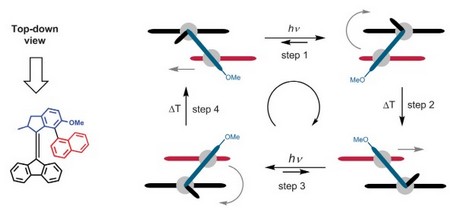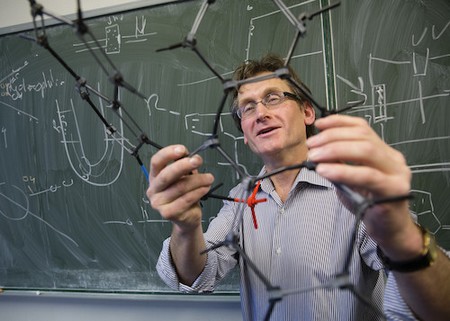Locked movement in molecular motor and rotor
For a motor to power machinery, the local motion has to be translated into the ordered movement of other parts of the system. University of Groningen organic chemists led by professor Ben Feringa are the first to achieve this in a molecular motor. They have produced a light driven rotary motor in which the rotary movement is locked to that of a secondary naphthalene rotor. The results will be published on 2 June in the journal Science.

The naphthalene rotor is attached to the motor by a single carbon-carbon bond, which allows it to rotate freely. But the design of the system has been tweaked to control its movement. In the same way as the Moon orbits the Earth but keeps the same side towards us, the naphthalene rotor keeps the same relative position to the motor while describing a circle around it.
‘It took some tricky stereochemistry to build this system. I think we’ve spent four or five years working on it’, says Feringa, who was one of recipients of the 2016 Nobel Prize for Chemistry for his pioneering work on molecular motors. ‘But we have now taken a fundamental step in the development of molecular machines: the synchronization of movement.’
Balance
During the four steps it takes the motor to make one full revolution, the naphthalene rotor is limited in its movement by the rest of the molecule. This is how the two movements are coupled. ‘We had to carefully strike a balance between limiting the movement of the rotor, while allowing it to change its position.’ The team designed and built two versions, in which the rotor was either pointing inwards or outwards, and was pushed or pulled by the motor.

By locking two moving parts, the Feringa group has taken another step towards building molecular machines. ‘In biology, you see many of these systems where molecules are connected in a cog-like manner, which can synchronize or amplify movement. As far as I’m aware, this has never been done in artificial systems like our own.’
The system which the Feringa group describes in Science has no practical application. ‘Like when we built our first molecular car six years ago to show that it is possible to use the revolving motion of our molecular motor to create directional movement on a surface’, says Feringa. ‘This time we have shown it is possible to transmit movement.’
Reference: Peter Štacko, Jos C. M. Kistemaker, Thomas van Leeuwen, Mu-Chieh Chang, Edwin Otten, Ben L. Feringa: Locked synchronous rotor motion in a molecular motor Science, 2 June 2017, DOI 10.1126/ science.aam8808
| Last modified: | 02 June 2017 09.16 a.m. |
More news
-
23 April 2024
Nine MSCA Doctoral Network grants for FSE researchers
Nine researchers of the Faculty of Science and Engineering have received a Horizon Europe Marie Sklodowska Curie Doctoral Network grant.
-
22 April 2024
Charissa Roossien secures JTF subsidy to develop Health Tracker
Dr. Charissa Roossien (ENTEG) has successfully secured a Just Transition Fund (JTF) subsidy of 1.8 million euros to develop a Health Tracker for reliable respiratory and metabolic analysis.
-
15 April 2024
Night vision with artificial atoms
Every two weeks, UG Makers puts the spotlight on a researcher who has created something tangible, ranging from homemade measuring equipment for academic research to small or larger products that can change our daily lives. That is how UG...
